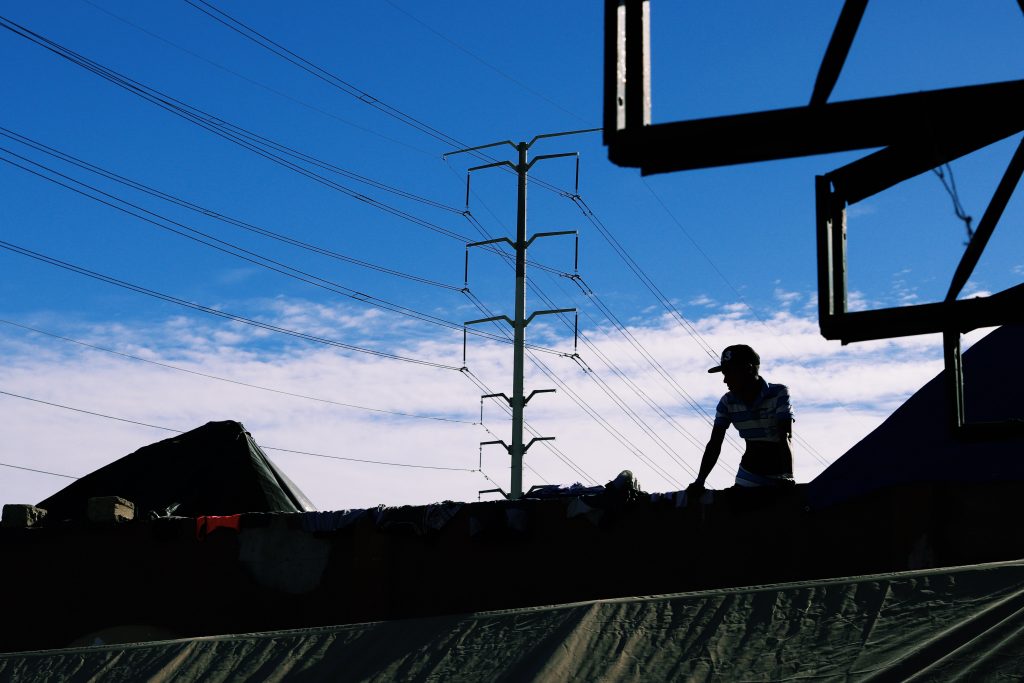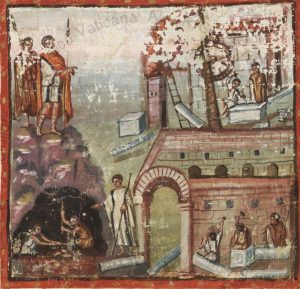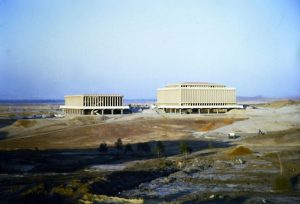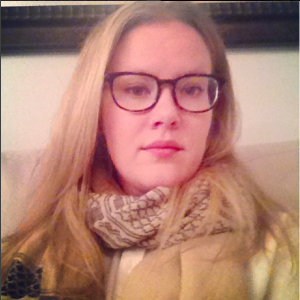“A borderland is a vague and undetermined place created by the emotional residue of an unnatural boundary.” Gloria Anzaldúa, Borderlands/La Frontera

Founder, Enrique Morones, addresses volunteers outside Border Angels San Diego office. Photo by Gabriel Briano.
Having administered finals to my students and submitted a dissertation chapter to my advisor, I hopped in my car and drove off towards Mexico. I didn’t press pause on my diligent grading of Bluebooks just to go blow off steam after a long fall quarter, rather I went to deliver donations to Central American asylum-seekers living in migrant shelters in Tijuana.
This so-called Caravan of Love was organized by the Border Angels, a San Diego-based migrant aid non-profit. Since this trip to the migrant shelter, my brain has raced with a mirage of sights, sounds, questions, and lessons of that day. This post is a result of my churning, restless mind. I want to share some experiences of this day as a way to reflect on my efforts as a scholar-activist (a scholar who uses the privileges of academia to serve marginalized communities). Here, I evaluate my own positionality and privileges in order to grow as I continue my uneven and ongoing endeavor to be a scholar-activist. In a very meta way, I also imagine this post itself as part of the process of scholar-activism in that I write in hopes of empowering undergraduates, fellow grad students, and established scholars to feel emboldened to partake in the challenge of scholar-activism. I’m directly asking Humanities Core students to ponder the potential real-life implications of their training in the humanities.
Furthermore, I hope to shed light on the growing humanitarian crisis along the U.S.-Mexico border by bringing together its historical context with what I witnessed first-hand (albeit from a brief and extraordinarily limited perspective).
My scholar-activism often feels as messy and complicated as my own identity. I am a mixed-race Filipino American woman (Filipino father and white mother) born and raised in Virginia. I attribute the realities of my family’s immigration story and growing up in the south as having led me to the humanities in general and the study of migration history in particular. Indeed, as an undergraduate I turned to the humanities in search of answers to my brewing questions about race, empire, and migration. Now I am a PhD candidate in history at UC Irvine, where I am writing a dissertation on Central American refugee policies in the 1980s (the historical moment in which today’s migration crisis has its roots). As a Filipina American and historian of migration, I have both personal and professional investments in immigration justice.
In response to the increasingly volatile media coverage of the Caravan of Central Americans fleeing violence and hunger, I decided to act. So, in December, my partner Gabriel, a Mexican American photographer (whose photos I have included in this essay), joined me in volunteering with the Border Angels. I had worked with this group on multiple occasions over the last few years, participating in their desert water drops and day labor outreach. This time we were taking supplies that they had been collecting for over a month and delivering them to Tijuana.
As a historian, I know the history of the U.S. policies towards Central America is long and sordid. I also understand that U.S. violence towards Central American refugees, asylum-seekers, and immigrants is not a new phenomenon. Yet, I’m still astounded by the violent policies toward Central American migration under the Trump administration. The Caravan, child separation, the tear gassing of families at the border, the death of children in U.S. border patrol custody have all become more visible to non-Central American communities. I hoped that maybe by volunteering at the shelter these disturbing events would make more sense.
It didn’t. The trip to Tijuana made nothing make sense. If anything it raised more questions as I, a privileged outsider, looked on at the scenes of the migrant shelter known as El Barretal. In it I saw just a snapshot of something I do not truly understand. El Barretal was a place of potentially dehumanizing conditions that, to my eye, was still bubbling over with humanity (including the little boy who was literally and joyfully blowing bubbles).
On Saturday, December 15th, 2018, we met a group of volunteers at the Border Angels office. We organized donations, we waited, we listened, we waited some more. Then we loaded the boxes and bags of the donations into our cars. Together we were 12 cars caravanning south to three different Tijuana shelter locations in three separate groups. In our group, unsure of both address and directions, the volunteer drivers of four cars scrambled to follow the vehicle of Border Angels veteran, Hugo Castro. I may or may not have boldly ran two red lights to keep up as Hugo led our group to El Barretal, a vacant nightclub-turned migrant shelter.
Upon arriving we parked on the cramped Tijuana street brimming with city life. On top of the already busy Tijuana car and foot traffic was the newly added Mexican military, federal police, and other government officials guarding the area, international volunteers unloading donations, and Central American migrants coming in and out of the shelter grounds.
After the hectic process of unloading the supplies into the storeroom, where they would be processed and distributed, those running the shelter suggested that the Border Angels volunteers visit the main living quarters. We were instructed to sign-in and exchange our identification for visitors’ passes. We then entered through a maze of steel barricades that opened into the half-indoor half-outdoor living space. Immediately, we were greeted by the sights and sounds of men singing, kids playing, and people selling snacks and cigarettes. An official explained to us that the front part (mostly open air) of the once vacant grounds now served as the living area for single men, while the enclosed back side served to house women and families.
We saw the outdoor showers and portable toilets for the women and children before we entered the main living area for the families. Hundreds of tents populated the large indoor space. It almost looked like a warehouse except for the stage, bar, and dance floor that peeked out from behind the mass of tents, betraying the former nightclub.
With no specific instruction on how to spend our time, the ten members of our group started breaking off on their own. Some of the volunteers interviewed women and children who were sitting among the tents. Gabriel joined two other experienced photographers in trying to capture daily life. Hugo gave an interview to a journalist about the Border Angels’ work. I chose to play with some kids because I found their cheerful energy contagious. We threw a ball, we pushed around a toy firetruck, and we stacked some blocks. Many children were laughing and playing. In a display of resourcefulness, the older kids were even using strollers to zoom their younger siblings around the concrete floor.
Our group stayed for only an hour or so after accomplishing the main task of delivering the donations before heading back to the United States. On the long drive home, which included a 3.5 hour wait at the U.S. border, I had plenty of time to discuss the day’s events with Gabriel and another volunteer. We each expressed our discomfort at what felt — regardless of our intentions — voyeuristic at times. As we neared the parking lot in Irvine, Gabriel lamented that his approach to the photos had to be from the outside looking in. “There were some things I could capture. But others I just couldn’t. Like the insides of the tents.”
Indeed, since this trip, I have done much reflection on what I cannot see or understand as a volunteer, as a historian, or as a scholar-activist. From my limited perspective, I’ll never know what really happened on their journey to Tijuana. I’ll never understand the hopes or anxieties about what might come next. I can’t see what it’s like at night, the dreams, the nightmares. The prayers, tears, jokes inside the tents aren’t for me to hear.
But what can I contribute as a scholar-activist?
I can tell you what I did see. I saw first-hand that donations are still greatly needed. They are not being wasted. They are used and are precious. If you have the resources, please donate.
I can ask you to volunteer your time with the Border Angels and other organizations, who need volunteers that are privileged enough to move across the U.S.-Mexico border with relative ease — in that they have a U.S. passport, a vehicle, and the time to sit in the return lane for 3-4 hours. I have found that much of this work is waiting, but this is because much of this work is about being there, being a witness. This is even more important now, as conditions at El Barretal and other shelters rapidly deteriorate.
I can remind you that U.S. intervention in Central America and U.S. immigration policy are the most significant historical factors in the creation of the migrant crisis. Read about it. There are lots of books and articles written on this subject, including many by Central American scholars (see Abrego and Menjívar).
Finally, I can share that I witnessed humanity and hope manifesting within what continuously threatens to be dehumanizing conditions. Do not look away from these families.
For me, scholar-activism is a tangled web of personal and professional investments that simultaneously enrich and clash with each other. The efforts both empower me and leave me self-critical. In many ways my experiences at the end of last quarter exemplify my attempt to juggle my commitments to research, teaching, and activism.
I struggled with how to approach this post. I wanted it to be useful to somebody beside myself. I hoped to promote scholar-activism within higher education, while pushing myself and others to think critically of how they use their privilege. I desired to share what I saw in El Barretal. I tried to do all of this, just like I tried to understand the humanitarian crisis at the border. I likely didn’t succeed in all these things. But maybe that’s okay. Maybe what’s most important is that I keep trying to do better.
Works Cited
Abrego, Leisy J. Sacrificing Families: Navigating Laws, Labor, and Love across Borders. Stanford, California: Stanford University Press, 2014.
Anzaldúa, Gloria. Borderlands/La Frontera. San Francisco: Aunt Lute Books, 2012.
BBC News. Trump and the Facts about the Migrant Caravan – BBC News. Accessed January 14, 2019.https://www.youtube.com/watch?v=ETUqj2Fi9ZA.
“‘Caravan of Love’ Delivers Necessities, Moral Support to Migrants Camped in Tijuana – The San Diego Union-Tribune.” Accessed January 14, 2019.https://www.sandiegouniontribune.com/news/border-baja-california/sd-me-caravan-of-love-20181208-story.html.
Cervantes, Cecilia Menjívar and Andrea Gómez. “El Salvador: Civil War, Natural Disasters, and Gang Violence Drive Migration.” migrationpolicy.org, August 27, 2018.https://www.migrationpolicy.org/article/el-salvador-civil-war-natural-disasters-and-gang-violence-drive-migration.
“Border Angels-Home.” Accessed January 14, 2019.https://www.borderangels.org/.
“Life Becomes More Uncertain for Migrant Families Camped in Tijuana | 89.3 KPCC.” Accessed January 14, 2019.https://www.scpr.org/news/2018/12/24/87652/life-becomes-more-uncertain-for-migrant-families-c/.
Menjívar, Cecilia. Immigrant Families. Immigration & Society Series. Cambridge: Polity Press, 2016.
“Mexico: Tijuana Declares Humanitarian Crisis over Migrant Caravan | World News | The Guardian.” Accessed January 14, 2019. https://www.theguardian.com/world/2018/nov/24/mexico-tijuana-declares-humanitarian-crisis-over-migrant-caravan.
“Migrants in Tijuana Know Trump Doesn’t Want Them. They Aren’t Giving Up. – The New York Times.” Accessed January 14, 2019. https://www.nytimes.com/2019/01/05/world/americas/tijuana-mexico-migrant-caravan.html.
“Missing Border Angels Activist Found Alive in Mexico – The San Diego Union-Tribune.” Accessed January 14, 2019. https://www.sandiegouniontribune.com/news/courts/sd-me-castro-found-20170418-story.html.
“San Diego Advocates Seek Clothing, Blankets For Caravan Migrants | KPBS.” Accessed January 14, 2019. https://www.kpbs.org/news/2018/nov/27/san-diego-advocates-seek-clothing-blankets-caravan/.
“The Importance of Being a Scholar-Activist (Opinion).” Accessed January 14, 2019. https://www.insidehighered.com/advice/2018/03/30/importance-being-scholar-activist-opinion.
Tseng-Putterman, Mark. “A Century of U.S. Intervention Created the Immigration Crisis.” Medium, June 21, 2018. https://medium.com/s/story/timeline-us-intervention-central-america-a9bea9ebc148.
“UNHCR – Central American Refugees and Migrants Reach Mexico City.” Accessed January 14, 2019. https://www.unhcr.org/news/latest/2018/11/5be2ed814/central-american-refugees-migrants-reach-mexico-city.html.
“What Is Life like in El Barretal, the New Shelter for Caravan Migrants in Tijuana? – The Washington Post.” Accessed January 14, 2019 .https://www.washingtonpost.com/local/social-issues/a-makeshift-shower-in-a-muddy-courtyard-donated-meals-too-far-apart/2018/12/03/43c6e078-f67f-11e8-863a-8972120646e0_story.html?noredirect=on&utm_term=.a39bff2d5788.
“What Is the Caravan That Has Arrived in Tijuana and Why Is It Angering President Trump? – The Washington Post.” Accessed January 14, 2019. https://www.washingtonpost.com/local/immigration/the-trump-administration-vs-the-caravan-heres-what-you-need-to-know/2018/04/26/921636be-489e-11e8-827e-190efaf1f1ee_story.html?utm_term=.ca33cbbb0f71.
“Where to Donate to Help Migrant Children and Families at the Border.” Accessed January 14, 2019. https://www.cnbc.com/2018/06/20/where-to-donate-to-help-immigrant-children-and-families-at-the-border.html.
 Rachael De La Cruz is a Ph.D. Candidate in history at the University of California, Irvine. She specializes in Central American history, migration studies, and gender. Her dissertation, entitled “Surveillance, Settlements, and Sanctuary: Comparative Refugee Policies in Central America during Salvadoran Civil War,” examines the treatment of Salvadoran refugees in other Central American countries during the 1980s. Her article “No Asylum for the Innocent: Gendered Representations of Salvadoran refugees in the 1980” was published in the Gender and Migration special edition of the American Behavioral Scientist.
Rachael De La Cruz is a Ph.D. Candidate in history at the University of California, Irvine. She specializes in Central American history, migration studies, and gender. Her dissertation, entitled “Surveillance, Settlements, and Sanctuary: Comparative Refugee Policies in Central America during Salvadoran Civil War,” examines the treatment of Salvadoran refugees in other Central American countries during the 1980s. Her article “No Asylum for the Innocent: Gendered Representations of Salvadoran refugees in the 1980” was published in the Gender and Migration special edition of the American Behavioral Scientist.












 auchamp is a seminar leader in the Humanities Core Course at UC Irvine, where she received her Ph.D. from the Department of Comparative Literature. When she isn’t hiking at Crystal Cove State Park or proselytizing about Orange County Taco Tuesday venues, she writes about the conjunction between literary modernisms and the clinical development of psychoanalysis, especially as it maps onto questions of race, gender, and sexuality. She will be acting as editor and moderator of this space as it evolves over the next year.
auchamp is a seminar leader in the Humanities Core Course at UC Irvine, where she received her Ph.D. from the Department of Comparative Literature. When she isn’t hiking at Crystal Cove State Park or proselytizing about Orange County Taco Tuesday venues, she writes about the conjunction between literary modernisms and the clinical development of psychoanalysis, especially as it maps onto questions of race, gender, and sexuality. She will be acting as editor and moderator of this space as it evolves over the next year.